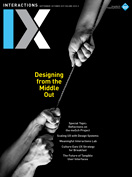Authors:
Helena Mentis, Mark Perry
What is SIGCHI? What does SIGCHI do for me? Who in SIGCHI should I speak to? While these might seem like simple questions, the answers are not always straightforward. As an organization, SIGCHI supports more than 20 sponsored and more than 40 in-cooperation conferences, provides coordination for 56 chapters across 38 countries, and offers financial assistance to advance HCI education, research, and practice through workshops and outreach activities. Numerous people are involved in making this a successful and dynamic community. However, as SIGCHI is volunteer-based, actually finding out the proper contacts and how to get involved can be a bit daunting. SIGCHI is highly distributed and decentralized, so it is useful to outline how the different parts are organized to support its activities. This article sets out to briefly cover what SIGCHI does, the diverse activities in which its members are involved, and how it is organized.
Whenever SIGCHI members want to make change happen in their disciplines or practice, engage with their communities, or grow the field through education or training activities, it is likely that SIGCHI volunteers will work to make these possible. The most visible representatives of SIGCHI are the Executive Committee (EC), a 12-member group of elected and appointed volunteer officers. However, the majority of work happens through other teams, committees, subcommittees, boards, and working groups, driven by agenda and strategy. The tasks of making conferences happen, getting journal articles published, aligning with the activities of our parent organization ACM, and planning a wide range of other events are carried out across multiple committees, all of which are supported in their endeavors by the SIGCHI EC.
If SIGCHI is anything, it is its members. Its volunteers all come from within the SIGCHI community.
The chairs and committees of local chapters all function independently, supported by the VP of Chapters and ACM. The bylaws of SIGCHI allow for organizational flexibility to respond to immediate community needs, so it also has a variety of ad hoc committees, such as its Inclusion teams, which support diversity, and the CHI 2030 Visioning Task Force, envisioning what the flagship CHI conference might look like in the future so that it continues to benefit members. The editors of ACM Interactions and SIGCHI's TOCHI and PACM work with their associate editors and reviewers to produce a wide variety of publication formats to support our members' needs. What's more, the SIGCHI awards committees look to reward and celebrate professional achievements, soliciting nominations, vetting candidates, and choosing winners. VP conference committees also exist: Conference Operations, Conferences Board, Conference Working Group, Council of Steering Committee Chairs, CHI Steering Committee, Research Ethics Committee, and the multitude of Conference Series Committees, for which the SIGCHI organization acts as a connective infrastructure. Looping back, SIGCHI provides representatives on ACM-level committees such as the Education Council and Publications Board, ensuring that human-technology and human-computer interaction remain at the heart of computing as a science and profession.
However, if SIGCHI is anything, it is its members. Its volunteers all come from within the SIGCHI community: us, not them. SIGCHI relies on the contributions of volunteers to achieve its mission. We need members to get involved if we are to make a difference, so please connect with us at whatever levels you feel able to contribute. We work hard to build this community, increase its representativeness and diversity, and cement its relevance for the future. Come join us!
Helena Mentis, SIGCHI President, [email protected]
Mark Perry, SIGCHI Adjunct Chair for Volunteer Development, [email protected]
Copyright held by authors
The Digital Library is published by the Association for Computing Machinery. Copyright © 2019 ACM, Inc.








Post Comment
No Comments Found